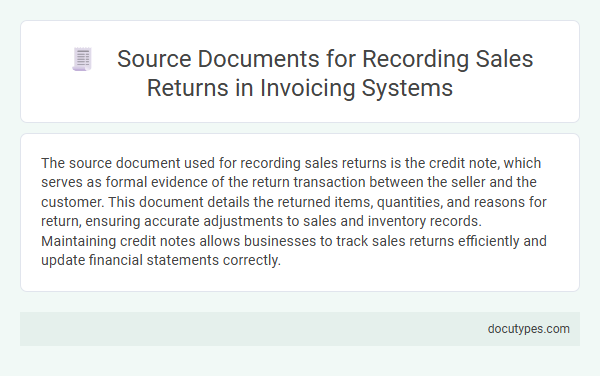The source document used for recording sales returns is the credit note, which serves as formal evidence of the return transaction between the seller and the customer. This document details the returned items, quantities, and reasons for return, ensuring accurate adjustments to sales and inventory records. Maintaining credit notes allows businesses to track sales returns efficiently and update financial statements correctly.
Understanding Sales Returns in Invoicing Systems
| Topic | Source Document Used for Recording Sales Returns |
|---|---|
| Definition | Sales returns refer to goods that a customer sends back to the seller after a purchase due to defects, errors, or dissatisfaction. |
| Primary Source Document | Credit Note |
| Purpose of Credit Note | Used to officially record the return of goods by a customer and to adjust the sales ledger accordingly. |
| Role in Invoicing Systems | Credit notes reduce the amount receivable from the customer by referencing the original sales invoice and specifying the returned items and value. |
| Data Included in Credit Note | Customer details, original invoice number, date of return, description and quantity of returned items, reason for return, adjusted amounts. |
| Integration in Accounting Records | Sales returns recorded via credit notes update both accounts receivable and inventory levels, reflecting the returned products and financial impact. |
| Importance | Using credit notes ensures accuracy in sales reporting, corrects revenue figures, and maintains transparent transaction history. |
Importance of Source Documents for Sales Returns
Source documents are critical for accurately recording sales returns, providing proof and details of the transaction adjustments. Using the correct source document ensures your financial records reflect returned goods precisely.
- Credit Note - The primary source document issued by the seller to authorize and record a sales return.
- Sales Return Voucher - A document created to log the physical return of goods and adjust inventory accordingly.
- Invoice Reference - The original sales invoice is referenced to validate the transaction and align returns with initial sales.
Types of Source Documents Used in Sales Returns
Sales returns are recorded using specific source documents that provide accurate transaction details. These documents serve as evidence for goods returned by customers and help maintain proper accounting records.
The most common source document used for recording sales returns is the Sales Return Note or Credit Note. This document specifies the returned items, quantities, reasons for return, and the value deducted from the original sale.
Credit Notes: Essential Document for Sales Returns
Credit notes serve as the primary source document for recording sales returns. These documents provide detailed information about the returned goods, including quantities, prices, and reasons for return. Your accounting records rely on credit notes to accurately adjust sales figures and inventory levels.
Sales Return Vouchers and Their Role
Sales returns are recorded using specific source documents known as Sales Return Vouchers. These vouchers serve as official records for goods returned by customers, ensuring accurate accounting and inventory adjustments.
- Sales Return Voucher - A document issued to record the return of goods from a customer to the seller.
- Role in Accounting - It provides evidence to adjust sales revenue and update inventory balances accordingly.
- Source Verification - Used as a primary source document to validate entries in sales returns journals and financial statements.
Invoice Adjustments and Source Document Tracking
The source document used for recording sales returns is typically the credit memo or the original sales invoice adjusted to reflect the return. Invoice adjustments ensure accurate tracking of returned goods, maintaining correct account balances and inventory records. Effective source document tracking supports audit trails and enhances the accuracy of financial reporting related to sales returns.
Recording Procedures for Sales Return Source Documents
The source document used for recording sales returns is the sales return invoice or credit memo. This document serves as an official record that authorizes the return of goods from the customer to the seller.
- Sales Return Invoice - Acts as proof that merchandise was returned and specifies the quantity and reason for the return.
- Recording Procedure - The return invoice is entered into the sales return journal to update inventory and accounts receivable.
- Authorization - The source document must be approved by the sales manager or accounting department before processing the return.
Accurate recording of sales return source documents ensures proper adjustment of revenue and inventory balances.
Digital vs. Paper Source Documents in Invoicing
Which source document is used for recording sales returns in invoicing? Sales returns are typically recorded using credit memos as the primary source document. Digital credit memos streamline the process, offering faster updates and easier tracking compared to traditional paper documents.
Audit Trails and Compliance with Sales Return Documentation
The source document used for recording sales returns is typically the Sales Return Memo or Credit Note. This document evidences the return transaction and initiates the adjustment in the accounting system.
Maintaining a clear audit trail requires the Sales Return Memo to include details such as customer information, return reason, product details, and authorization signatures. Proper documentation ensures compliance with internal controls and regulatory requirements. This practice facilitates accurate tracking and verification of return transactions during audits.
Which Source Document Is Used for Recording Sales Returns? Infographic

